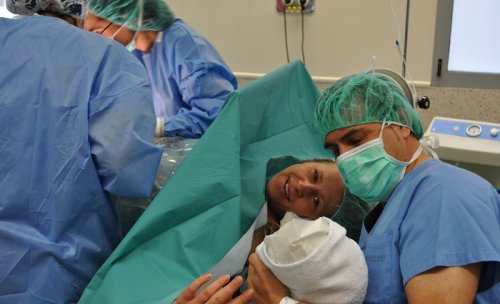Benefits of Having Someone With You During Childbirth

The simple presence of having someone with you during childbirth is a good incentive for any mother, making her feel supported, relaxed and in control. Science backs this up.
It isn’t quite common for mothers to be accompanied during childbirth by family, friends or a doula. This was impossible decades ago.
In some hospitals there are still many restrictions, but some have been relaxed thanks to the benefits of allowing the mother to be accompanied during delivery.
It was necessary to study this topic to demonstrate that, for example, in the face of stress, a pregnant woman feels better about having someone she trusts on her side, offering support and help.
And although the benefits of having company during pregnancy go beyond this list, here are seven advantages that outline how positive it is to give birth to your baby while surrounded by loved ones.

1. When you are accompanied, delivery is shorter
Being accompanied at all times reduces the duration of labor. In theory and from collected experiences, it can be reduced by up to 43 minutes, all thanks to the calm and peace provided to the mother by her partner or companion.
This occurs because anxiety and fear of giving birth generate abnormal heart rate patterns in the fetus, slow contractions and prolong delivery.
2. With someone at your side, childbirth becomes easier
Accompanied mothers are more likely to have a natural birth and not a surgical one, and also are less likely to need pain killers.
Research suggests that support increases the mother’s sense of control and empowerment, and therefore reduces her dependence on medical interventions, including an epidural. As stress levels lower, the passage of the baby through the pelvic region becomes easier.
3. The delivery experience is better if you are not alone
Mothers who had company felt more satisfied with their delivery experience, especially those who had their partner’s presence from the beginning of labor.
4. Your companion can help time contraction intervals
Your companion should be sure to have a watch with a timer in order to time the contractions from the beginning of one to the beginning of the next. If the interval is 8 to 10 minutes and each contraction lasts between 30 and 45 seconds, this indicates the early stages of labor.

5. Your companion can maintain contact with the attending doctor
Being in contact with your doctor is very important, because with the information that your companion gives them, the specialist can decide (taking into account the timing of contractions) when you should go to the hospital.
6. They calm you down and cheer you up
When you are tense, your body becomes extremely rigid or you may think a surgical intervention is necessary, when more than ever you need your companion, who will do everything possible to reassure you, encourage you or calm you.
Being aware that childbirth may not develop naturally and therefore may require medical attention can make the mother feel even more vulnerable and in need of support and calm that the companion can provide.
7. They tend to your needs (thirst, cold, hot)
From the moment your water breaks, you will begin to demand a lot of attention from your companion. Continuous communication between the two of you is important, because it will help you make sure nothing is missing from your luggage.
Your companion must have a lot of patience, especially if you are a first-time mother. If this is the case, your companion must provide security during childbirth with motivating words, by holding your hands and remembering the proper way to breathe.
All cited sources were thoroughly reviewed by our team to ensure their quality, reliability, currency, and validity. The bibliography of this article was considered reliable and of academic or scientific accuracy.
- Villalón, H., Toro, R., Riesco, I., Pinto, M., & Silva, C. (2014). Participación paterna en la experiencia del parto. Revista chilena de pediatría, 85(5), 554-560. https://scielo.conicyt.cl/scielo.php?pid=S0370-41062014000500005&script=sci_arttext
- Abad, M. L., Martos, J. S., Cazalilla, M. C. G., Chica, A. B., Rivera, M. D. C. O., Guijosa, A. B. R., & Lorite, M. P. G. (1999). El padre en la experiencia del parto: valoración del acompañamiento a su pareja. Revista de Enfermería, (10), 5-11. https://dialnet.unirioja.es/servlet/articulo?codigo=6612216
- Serrano, M. M., Torres, C. U., & Hoga, L. A. (2018). Padre preparado y comprometido en su rol de acompañante durante el proceso de parto. Aquichan, 18(4), 415-425. https://dialnet.unirioja.es/servlet/articulo?codigo=7004529
